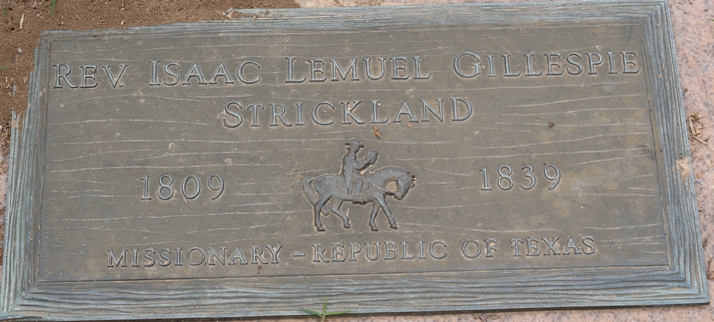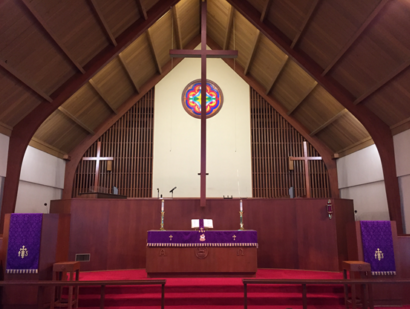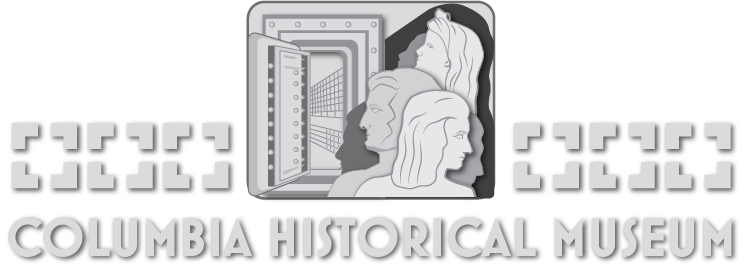![]()
By Winston C. Avera Jr.
Since 1839, there has been a fellowship at Columbia Methodist Church, organized for the worship of God and the service of man. The Columbia United Methodist Church was first organized as a Methodist Society by Rev. Isaac L. G. Strickland in April 1839. On May 7 of that year, Strickland wrote from Egypt to Rev. Littleton Fowler, his superior:
“Next morning left for Columbia, very sick. Reached my appointment and preached in great weakness. Afterwards took medicine and stayed at Mrs. Bell’s unable to go to Houston by Sunday. I thought I could preach, had an appointment made. Preached and formed a society in the place, six members, so I hope I did some good.”
This has been called the oldest Methodist Church in Brazoria County, which may well be true. Homer S. Thrall, who served this church in 1843, wrote in his History of Methodism in Texas about Littleton Fowler who was appointed missionary to Texas in the summer of 1837:
“Mr. Fowler remained in the West, travelling as far down the country as Brazoria County, where he organized a small church, receiving as members Mr. and Mrs. J. P. Caldwell and others.”
First of a two-part story
No definite location is given to this church and a Mr. and Mrs. J. E. Caldwell are mentioned as members of the Columbia church in 1840. In his second book called A Brief History of Methodism in Texas, Thrall writes of Isaac Strickland:
“He organized the first Methodist Church in Columbia, Brazoria County in 1839, consisting of the following members: Morgan Rector and Amelia Rector, his wife, Mrs. Mary Knox, who became the wife of Rev. Jesse Hord in 1883, and died near Goliad about 1885, Miss Celia Rector, still living, and Miss Amelia Rector, still living.”
Whether there was an earlier Methodist Church in Brazoria County is inconclusive, but it is well established that The Columbia Methodist Church was organized in 1839.
There are many references to early missionaries in this area, even before the days of the Republic, when Catholicism was the official religion and it was required to “kiss the Bible and promise to be converted” before acquiring land. There is a record of John Wesley Kinney preaching at Columbia and Brazoria in 1834. Hoping to keep down trouble, Austin was reluctant to allow circuit riders to come, saying that one Methodist preacher would do more harm in his colony than a dozen horse thieves. In a letter to Josiah H. Bell dated February 24, 1829, Austin wrote:
“The subject of preaching must be managed with prudence, for I do assure that it will not do to have the Methodist excitement raised in this country.”
Nevertheless, missionaries came.
According to Mary Austin Holley who reported in 1835 that Texas had developed a town building mania and mentions Brazoria, Columbia and Velasco, she goes on to say, “There is not to this day a church in the colonies.”
Macum Phelan estimates that 19 out of 20 Christians in Texas were Methodist and described Texas as a “great, beautiful, dry, windy, cotton, cattle, Methodist, live-oak state.” Some authorities chose to ignore the presence of non-Catholics. When Col. Jose de las Piedras was informed that there were Methodists holding meetings, he asked: “Are they stealing horses? Are they killing anybody?. . .then let them alone.”

Old Columbia Cemetery in West Columbia, Texas, is the site of this grave marker for Rev. Isaac Strickland, a native of Kentucky who was admitted to the Methodist ministry in Tennessee in 1833 and eventually ended up in Texas.
In 1837, missionaries from the Mississippi Conference were appointed to the “foreign field” of Texas, with Dr. Martin Ruter as superintendent in charge. There were 3 circuits in Texas; Houston, Washington and San Augustine. The Houston Circuit included Houston, Velasco, Columbia, Matagorda, Brazoria, Egypt, Texana and San Felipe. In 1838, a Texas Mission District was established, with Littleton Fowler as presiding elder. It included five districts, one of which was the Brazoria Circuit under Joseph P. Sneed.
In the winter of 1838, Isaac L. G. Strickland rode into Texas on horseback with Jesse Hord. At that time there were only four Methodist preachers in all of Texas. In March 1839, Mr. Strickland was assigned to the Brazoria Circuit. Strickland was a young man with only six years of experience behind him. Phelan writes:
“Though a young man and devoted to his work, as summer came on was stricken with fever and soon afterwards succumbed, dying at Columbia, where he had recently organized a church.”
The last entry in Strickland’s diary planned his itinerary for June including Brazoria on June 29th to 30th.
Strickland died on July 3, 1839, at the Josiah H. Bell home. Bell, who had died about a year before, had been a prominent Methodist, and his wife, Mary, was a Presbyterian who befriended preachers of every denomination.
Strickland was buried on the Bell Plantation under a live oak tree. His body was later removed to the church yard of the memorial Strickland Chapel at Chance’s Prairie, where a monument was erected. His tombstone read:
J. L. G. STRICKLAND
METHODIST PREACHER
DIED JULY 3, 1839
AGED 24 YEARS
“He fell at his post.”
Later research by Rev. A. Wayne Jones and Nell R. Tucker, a descendant of I. L. G. Strickland, determined that Strickland actually died at the age of 30, having been born in 1809 and that the “J” should have been “I” for Isaac. He lived only a few months after coming to Texas, but his stamp is indelible.
The early circuit rider faced floods, cold weather, Indians and loneliness. He was allowed the salary of $100 per year, plus traveling expenses, a horse and clothes and was expected to raise his own allowance.
On December 4, 1839, at the annual Mississippi Conference, the Texas Mission was divided into two districts with Robert Alexander being named presiding elder of the Rutersville District and Abel Stevens being named to the Brazoria Circuit.
By December 25, 1840, the Texas Conference had been established with 19 traveling and 25 local preachers. Five men, John Patton, Jordan Hill, James E. Caldwell, W. N. Kirk and Morgan Rector, were listed as members of the Columbia Church. In A Narrative History of Brazoria County, James Creighton states that the “Methodist Church in Columbia was officially formed on March 7, 1840,” referring to minutes of the Columbia Methodist Church, West Columbia, Texas, (which minutes can no longer be found). Wayne Jones writes that there were possibly other members, as these seem to have been officials of the church. Other names appear for 1842, 1843, etc.
There is no record of the exact place the church was first organized or of all the places church members met during the early years. The Senate Journal records that Sam Houston ordered that the Senate Chambers be cleared for the purpose of having a public preaching there every Sabbath. Apparently the various churches held services in this building.
Through the years the name of the fellowship at Columbia Methodist Church has changed as the church structure has changed. As a result of differing opinions over slave ownership, the Methodist Church divided in January 1845 and The Columbia Methodist Church became a part of the Methodist Episcopal Church, South.
Josiah H. Bell laid out towns two miles apart. One he called Columbia (present day West Columbia) and the other he called Marion (present day East Columbia). During the days of the Republic, Columbia was the larger town and it was there the church met. After the capital was moved, the population shifted to Marion, which then came to also be referred to as Columbia and the Methodist Church moved to this town.
The first record of a church building is a red brick one, built no doubt of handmade bricks from the red clay along the Brazos River. This building was situated on Lots 27 and 28 in Block 8 of present day East Columbia on Front Street, facing the Brazos River. It had a marble slab across the top inscribed Methodist Episcopal Church, South.
There is some uncertainty as to the date this brick church was built. One account reports that the first building was dedicated on June 2, 1844. Kate Underwood writes that “in 1855 the Methodists built a substantial brick church in Columbia and had a large membership there.”

The interior of the current Columbia Methodist Church as parishioners see it today in West Columbia
About this same time from 1854-1858, a pastoral residence for the resident preacher of Methodist Episcopal Church, South, on this circuit, was maintained on Lot 6, Block 9 of West Columbia (present day corner of Hamilton and Broad Streets).
In 1872, John Adriance conveyed land in the town of East Columbia, being the upper half of Lot 28, Block 8 on Front Street and the church building situated thereon, to the Trustees of the Methodist Episcopal Church, South.
Before many years, the river bank caved to such an extent that the foundation of the church cracked and the building was declared unsafe. The old brick building was destroyed and the land sold. By deed dated November 24, 1889, the trustees of the M. E. Church, South, conveyed to Sophie McKinney one-half of Lot 27, Block 8, being the “lot on which the old brick Methodist Church formerly stood.”
A new white frame church was built at the other end of this lot, this time facing Main Street, approximately across the street from the Aycock-Crews Bed & Breakfast. A picture of this church still exists. The exact date this church was built is not certain, but the church and a parsonage were standing by 1885. The church was damaged in the 1900 storm and the building was completely destroyed in the 1909 storm.
Story to be continued …

Enjoyed very much.
Very interesting read. Can’t wait for the next chapter